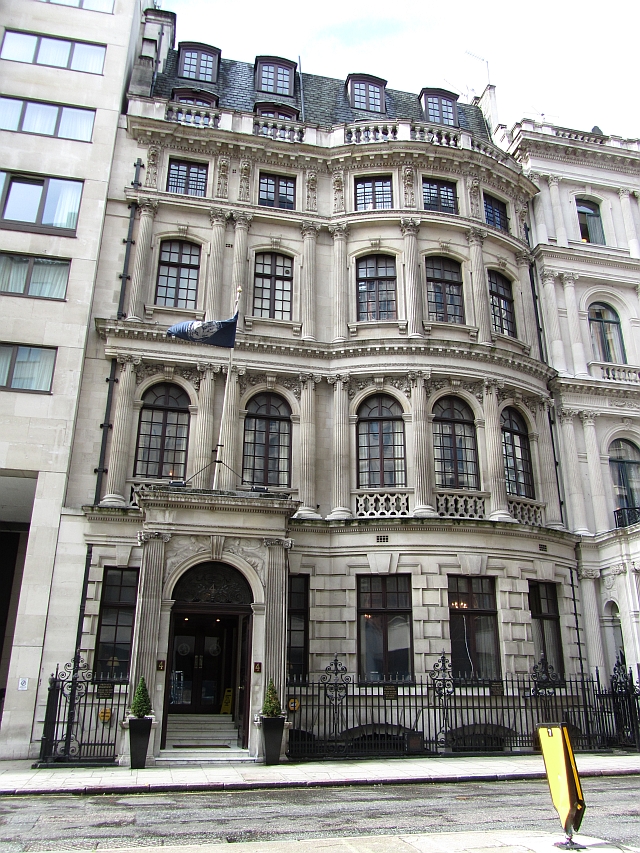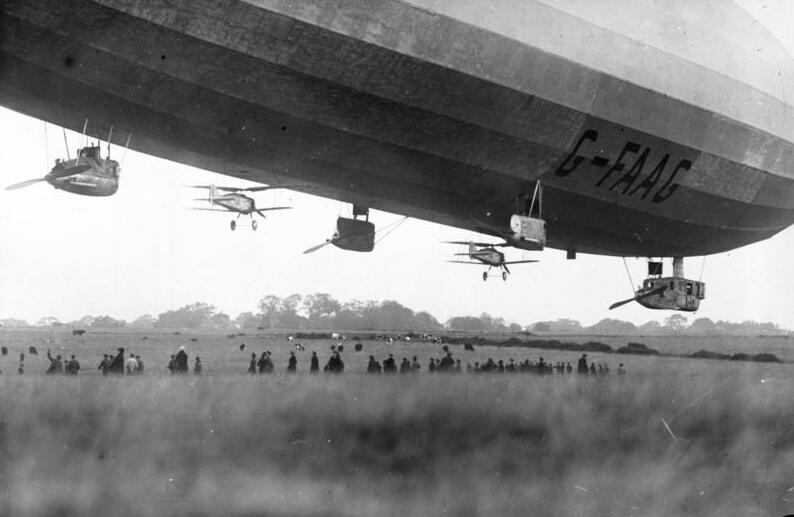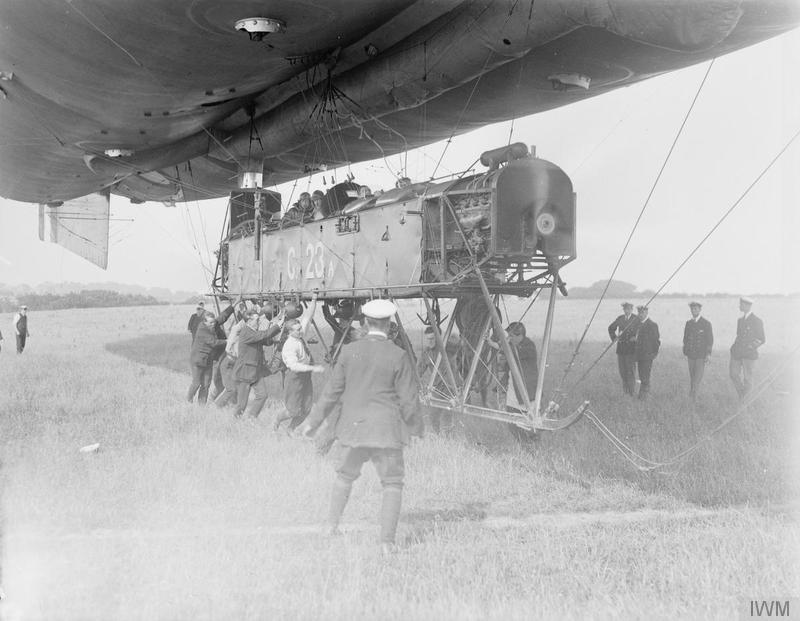|
J. E. M. Pritchard
Major John Edward Maddock Pritchard (1889 – 24 August 1921), was a British military officer who served in the RNAS, commanding non-rigid airships, and later in the Royal Air Force. He was the first pilot to navigate arrival in the United States by air from Europe. Pritchard was killed when the airship R38-class airship, R.38 broke its back and exploded in 1921. Early life Pritchard was born in Leighton Buzzard, Bedfordshire, in 1889. His father was of Welsh origin, but was born in the United States, and fought there during the Civil War. He was educated privately and at Trinity College, Cambridge. Following a post-graduate course at the Royal School of Mines, he was elected a Fellow of the Geological Society of London and took up a career as a mining engineer. World War 1 When World War I broke out Pritchard joined the Royal Naval Air Service and was posted to the Kite and Balloon School at Roehampton. In 1915 he was posted to the Airship Station at RNAS Kingsnorth, Kingsnort ... [...More Info...] [...Related Items...] OR: [Wikipedia] [Google] [Baidu] |
Leighton Buzzard
Leighton Buzzard ( ) is a market town in Bedfordshire, England, in the southwest of the county and close to the Buckinghamshire border. It lies between Aylesbury, Tring, Luton/Dunstable and Milton Keynes, near the Chiltern Hills. It is northwest of Central London and linked to the capital by the Grand Union Canal and the West Coast Main Line. The built-up area extends on either side of the River Ouzel (here about 2 metres wide) to include its historically separate neighbour Linslade, and is administered by the Leighton-Linslade Town Council. History Foundation and development It is unclear when the town was initially founded, although some historians believe that there may have been settlement in the area from as early as 571. There are a number of theories concerning the derivation of the town's name; ‘Leighton’ came from Old English ''Lēah-tūn'', meaning 'farm in a clearing in the woods', and ‘Buzzard’ was added by the Dean of Lincoln, in whose diocese the town lay ... [...More Info...] [...Related Items...] OR: [Wikipedia] [Google] [Baidu] |
Polegate
Polegate is a town and civil parish in the Wealden District of East Sussex, England, United Kingdom.OS Explorer map Eastbourne and Beachy Head Scale: 1:25 000. Publisher:Ordnance Survey – Southampton B2 edition. Publishing Date:2009. It is located five miles (8 km) north of the seaside resort of Eastbourne and is part of the greater area of that town. Although once a railway settlement, its rail links were closed as part of the Beeching cuts. The 2011 census put the civil parish of Polegate at a population of 8,586, with 41.2% aged 65 and over. History Until the coming of the railways in the 1840s, Polegate was a small settlement within the parish of Hailsham. The Roman road from Pevensey to Lewes passed through here, and the turnpike between London and Eastbourne was developed in the 18th century; but it was the opening of the railway between Lewes and Hastings, with later branches to Eastbourne and Hailsham, that meant growth for Polegate. It became a significa ... [...More Info...] [...Related Items...] OR: [Wikipedia] [Google] [Baidu] |
Royal Aeronautical Society
The Royal Aeronautical Society, also known as the RAeS, is a British multi-disciplinary professional institution dedicated to the global aerospace community. Founded in 1866, it is the oldest aeronautical society in the world. Members, Fellows, and Companions of the society can use the post-nominal letters MRAeS, FRAeS, or CRAeS, respectively. Function The objectives of The Royal Aeronautical Society include: to support and maintain high professional standards in aerospace disciplines; to provide a unique source of specialist information and a local forum for the exchange of ideas; and to exert influence in the interests of aerospace in the public and industrial arenas, including universities. The Royal Aeronautical Society is a worldwide society with an international network of 67 branches. Many practitioners of aerospace disciplines use the Society's designatory post-nominals such aFRAeS CRAeS, MRAeS, AMRAeS, and ARAeS (incorporating the former graduate grade, GradRAeS). ... [...More Info...] [...Related Items...] OR: [Wikipedia] [Google] [Baidu] |
R34 (airship)
The R.33 class of British rigid airships were built for the Royal Naval Air Service during the First World War, but were not completed until after the end of hostilities, by which time the RNAS had become part of the Royal Air Force. The lead ship, R.33, served successfully for ten years and survived one of the most alarming and heroic incidents in airship history when she was torn from her mooring mast in a gale. She was called a "Pulham Pig" by the locals, as the blimps based there had been, and is immortalised in the village sign for Pulham St Mary. The only other airship in the class, R.34, became the first aircraft to make an east to west transatlantic flight in July 1919 and, with the return flight, made the first two-way crossing. It was decommissioned two years later, after being damaged during a storm. The crew nicknamed her "Tiny". Design and development Substantially larger than the preceding R31 class, the R.33 class was in the design stage in 1916 when the German ... [...More Info...] [...Related Items...] OR: [Wikipedia] [Google] [Baidu] |
Paris Peace Conference (1919–1920)
The Paris Peace Conference was the formal meeting in 1919 and 1920 of the victorious Allies after the end of World War I to set the peace terms for the defeated Central Powers. Dominated by the leaders of Britain, France, the United States and Italy, it resulted in five treaties that rearranged the maps of Europe and parts of Asia, Africa and the Pacific Islands, and also imposed financial penalties. Germany and the other losing nations had no voice in the Conference's deliberations; this gave rise to political resentments that lasted for decades. The conference involved diplomats from 32 countries and nationalities. Its major decisions were the creation of the League of Nations and the five peace treaties with the defeated states; the awarding of German and Ottoman overseas possessions as " mandates", chiefly to Britain and France; the imposition of reparations upon Germany; and the drawing of new national boundaries, sometimes involving plebiscites, to reflect ethnic bounda ... [...More Info...] [...Related Items...] OR: [Wikipedia] [Google] [Baidu] |
First Armistice At Compiègne
The Armistice of 11 November 1918 was the armistice signed at Le Francport near Compiègne that ended fighting on land, sea, and air in World War I between the Entente and their last remaining opponent, Germany. Previous armistices had been agreed with Bulgaria, the Ottoman Empire and Austria-Hungary. It was concluded after the German government sent a message to American president Woodrow Wilson to negotiate terms on the basis of a recent speech of his and the earlier declared "Fourteen Points", which later became the basis of the German surrender at the Paris Peace Conference, which took place the following year. Also known as the Armistice of Compiègne (french: Armistice de Compiègne, german: Waffenstillstand von Compiègne) from the place where it was officially signed at 5:45 a.m. by the Allied Supreme Commander, French Marshal Ferdinand Foch, it came into force at 11:00 a.m. Central European Time (CET) on 11 November 1918 and marked a vi ... [...More Info...] [...Related Items...] OR: [Wikipedia] [Google] [Baidu] |
British Admiralty
The Admiralty was a department of the Government of the United Kingdom responsible for the command of the Royal Navy until 1964, historically under its titular head, the Lord High Admiral – one of the Great Officers of State. For much of its history, from the early 18th century until its abolition, the role of the Lord High Admiral was almost invariably put "in commission" and exercised by the Lords Commissioner of the Admiralty, who sat on the governing Board of Admiralty, rather than by a single person. The Admiralty was replaced by the Admiralty Board in 1964, as part of the reforms that created the Ministry of Defence and its Navy Department (later Navy Command). Before the Acts of Union 1707, the Office of the Admiralty and Marine Affairs administered the Royal Navy of the Kingdom of England, which merged with the Royal Scots Navy and the absorbed the responsibilities of the Lord High Admiral of the Kingdom of Scotland with the unification of the Kingdom of Great ... [...More Info...] [...Related Items...] OR: [Wikipedia] [Google] [Baidu] |
Flight International
''Flight International'' is a monthly magazine focused on aerospace. Published in the United Kingdom and founded in 1909 as "A Journal devoted to the Interests, Practice, and Progress of Aerial Locomotion and Transport", it is the world's oldest continuously published aviation news magazine. ''Flight International'' is published by DVV Media Group. Competitors include Jane's Information Group and ''Aviation Week''. Former editors of, and contributors include H. F. King, Bill Gunston, John W. R. Taylor and David Learmount. History The founder and first editor of ''Flight'' was Stanley Spooner. He was also the creator and editor of ''The Automotor Journal'', originally titled ''The Automotor Journal and Horseless Vehicle''.Guide To British Industrial History: Biographies: ''Stan ... [...More Info...] [...Related Items...] OR: [Wikipedia] [Google] [Baidu] |
RAF Cranwell
Royal Air Force Cranwell or more simply RAF Cranwell is a Royal Air Force station in Lincolnshire, England, close to the village of Cranwell, near Sleaford. Among other functions, it is home to the Royal Air Force College (RAFC), which trains the RAF's new officers and Aircrew. The motto, ''Altium Altrix'', meaning "Nurture the highest" appears above the main doors of the Officers Mess. RAF Cranwell is currently commanded by Group Captain Joanne Campbell. History The history of military aviation at Cranwell goes back to November 1915,Halpenny (1981), p.74 when the Admiralty requisitioned 2,500 acres (10 km2) of land from the Marquess of Bristol's estate. On 1 April 1916, the "Royal Naval Air Service Training Establishment, Cranwell" was officially born. In 1917 a dedicated railway station was established for the RNAS establishment on a new single track branch line from Sleaford, the train being known as The Cranwell Flyer.A J Ludlam, ''The RAF Cranwell Railway'' ... [...More Info...] [...Related Items...] OR: [Wikipedia] [Google] [Baidu] |
List Of Parseval Airships
The Parsevals were 22 airships built between 1909 and 1919 by the Luft-Fahrzeug-Gesellschaft (LFG) following the design of August von Parseval. In the 1920s and 1930s, three more airships were built following the Parseval-Naatz (PN) design. As with the rival Zeppelins, the airships were, in both English and German, referred to by the name of the inventor. (In German, the nouns were masculine, that is, "''der Parseval''", "''der Zeppelin''".) In contrast to the Zeppelins, the Parsevals were non-rigid or semi-rigid airships, with little or no stiffening structure inside the fabric envelope. The Zeppelins had a rigid internal framework made of duralumin. Both types relied on hydrogen gas to provide lift. Experimental airship The ''Versuchsluftschiff'' (meaning experimental airship) was Parseval's first model. It was rebuilt several times. *First flight on 26 May 1906 at Berlin's Tegel, a military field *Pilot: Captain von Krogh *Length: 48 m, Diameter: 4.8 m *Power plant: 62&nb ... [...More Info...] [...Related Items...] OR: [Wikipedia] [Google] [Baidu] |
RNAS Howden
RNAS Howden (later RAF Howden) was an airship station near the town of Howden south-east of York, England. History It was opened in March 1916 to cover the East Coast ports shipping from attacks by German U-boats during the First World War, with its first airship, the Coastal-class non-rigid airship arriving on 26 June 1916. From 1916 to 1918 Howden was a Royal Naval Air Service establishment, with the base transferring to the Royal Air Force when it was established on 1 April 1918. While airships flew on patrols from Howden until the end of the war, Howden-based airships never engaged in direct combat with German submarines.Delve 2006, p. 295. The station remained operational after the end of the war, with operations continuing to support minesweeping operations over the North Sea.Delve 2006, pp. 295–296. A new hangar, at the time the largest in the world, was completed in 1919. The No.2 Double Rigid Shed measured in length and clearance height. In 1921, the rigid ai ... [...More Info...] [...Related Items...] OR: [Wikipedia] [Google] [Baidu] |
Coastal Class Airship
__NOTOC__ The Coastal Class (often known as the C-Class or simply the 'Coastals') were a class of non-rigid airship or "blimp" used by the Royal Naval Air Service (RNAS) during World War I. The C-class blimp operated by the United States Navy after the war was a completely unrelated design. In total 35 Coastals were built, all at RNAS Kingsnorth, Kent. Entering service in 1916, the Coastal class remained in widespread service until 1918, with a few members of the class still in service at the signing of the Armistice, while others were replaced by the improved C-Star class as they became unfit for service. The blimps were used for long anti-submarine patrols in the Western Approaches and English Channel, protecting convoys from German U-boats. The Coastal class was one of the first aircraft types specifically designed to detect and attack submarines. History and design The C-Class was far from a new design. The prototype was built in 1915 by using the envelope from the No. 10 ... [...More Info...] [...Related Items...] OR: [Wikipedia] [Google] [Baidu] |
.jpg)




.jpg)

_Squadron%2C_Embraer_Phenom_100_MOD_45164824.jpg)

_airship_at_Howden_Q27507.jpg)
